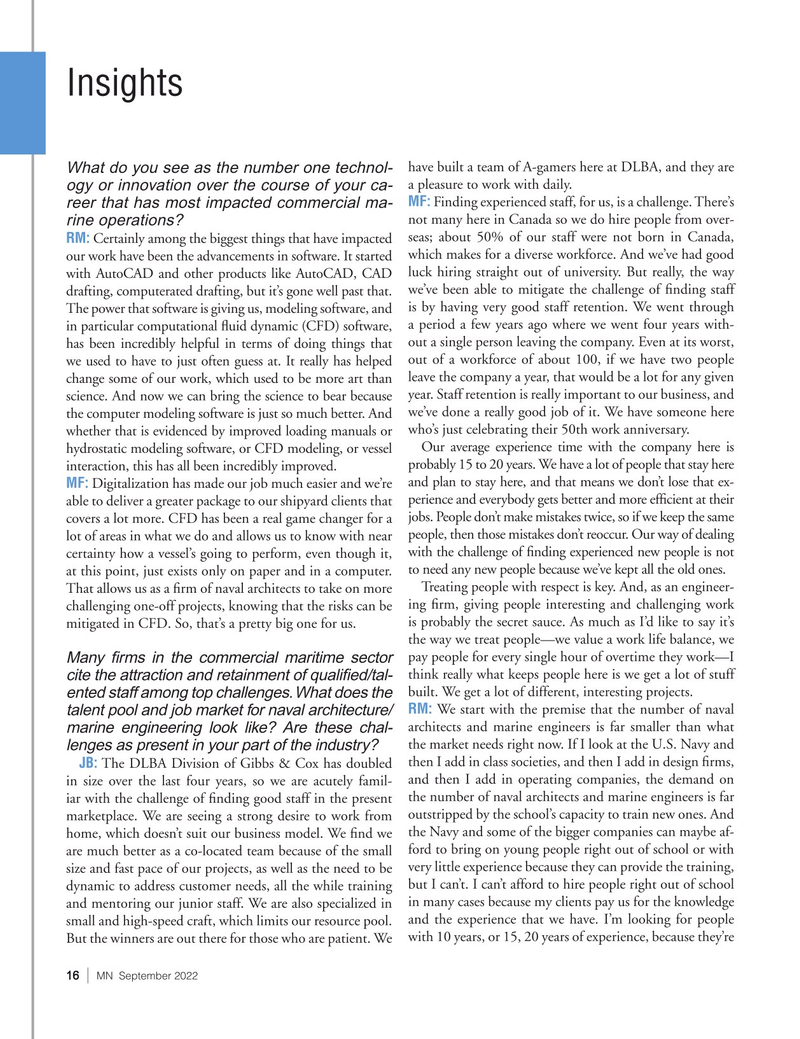
Page 16: of Marine News Magazine (September 2022)
Boatbuilding & Repair
Read this page in Pdf, Flash or Html5 edition of September 2022 Marine News Magazine
Insights have built a team of A-gamers here at DLBA, and they are
What do you see as the number one technol- a pleasure to work with daily. ogy or innovation over the course of your ca-
MF: Finding experienced staff, for us, is a challenge. There’s reer that has most impacted commercial ma- not many here in Canada so we do hire people from over- rine operations?
RM: Certainly among the biggest things that have impacted seas; about 50% of our staff were not born in Canada, our work have been the advancements in software. It started which makes for a diverse workforce. And we’ve had good with AutoCAD and other products like AutoCAD, CAD luck hiring straight out of university. But really, the way drafting, computerated drafting, but it’s gone well past that. we’ve been able to mitigate the challenge of ? nding staff
The power that software is giving us, modeling software, and is by having very good staff retention. We went through in particular computational ? uid dynamic (CFD) software, a period a few years ago where we went four years with- has been incredibly helpful in terms of doing things that out a single person leaving the company. Even at its worst, we used to have to just often guess at. It really has helped out of a workforce of about 100, if we have two people change some of our work, which used to be more art than leave the company a year, that would be a lot for any given science. And now we can bring the science to bear because year. Staff retention is really important to our business, and the computer modeling software is just so much better. And we’ve done a really good job of it. We have someone here whether that is evidenced by improved loading manuals or who’s just celebrating their 50th work anniversary.
Our average experience time with the company here is hydrostatic modeling software, or CFD modeling, or vessel probably 15 to 20 years. We have a lot of people that stay here interaction, this has all been incredibly improved.
MF: Digitalization has made our job much easier and we’re and plan to stay here, and that means we don’t lose that ex- able to deliver a greater package to our shipyard clients that perience and everybody gets better and more ef? cient at their covers a lot more. CFD has been a real game changer for a jobs. People don’t make mistakes twice, so if we keep the same lot of areas in what we do and allows us to know with near people, then those mistakes don’t reoccur. Our way of dealing certainty how a vessel’s going to perform, even though it, with the challenge of ? nding experienced new people is not at this point, just exists only on paper and in a computer. to need any new people because we’ve kept all the old ones.
Treating people with respect is key. And, as an engineer-
That allows us as a ? rm of naval architects to take on more challenging one-off projects, knowing that the risks can be ing ? rm, giving people interesting and challenging work is probably the secret sauce. As much as I’d like to say it’s mitigated in CFD. So, that’s a pretty big one for us.
the way we treat people—we value a work life balance, we pay people for every single hour of overtime they work—I
Many ? rms in the commercial maritime sector think really what keeps people here is we get a lot of stuff cite the attraction and retainment of quali? ed/tal- built. We get a lot of different, interesting projects.
ented staff among top challenges. What does the
RM: We start with the premise that the number of naval talent pool and job market for naval architecture/ architects and marine engineers is far smaller than what marine engineering look like? Are these chal- the market needs right now. If I look at the U.S. Navy and lenges as present in your part of the industry?
JB: The DLBA Division of Gibbs & Cox has doubled then I add in class societies, and then I add in design ? rms, and then I add in operating companies, the demand on in size over the last four years, so we are acutely famil- iar with the challenge of ? nding good staff in the present the number of naval architects and marine engineers is far marketplace. We are seeing a strong desire to work from outstripped by the school’s capacity to train new ones. And home, which doesn’t suit our business model. We ? nd we the Navy and some of the bigger companies can maybe af- are much better as a co-located team because of the small ford to bring on young people right out of school or with size and fast pace of our projects, as well as the need to be very little experience because they can provide the training, dynamic to address customer needs, all the while training but I can’t. I can’t afford to hire people right out of school and mentoring our junior staff. We are also specialized in in many cases because my clients pay us for the knowledge small and high-speed craft, which limits our resource pool. and the experience that we have. I’m looking for people
But the winners are out there for those who are patient. We with 10 years, or 15, 20 years of experience, because they’re 16 | MN September 2022

 15
15

 17
17
